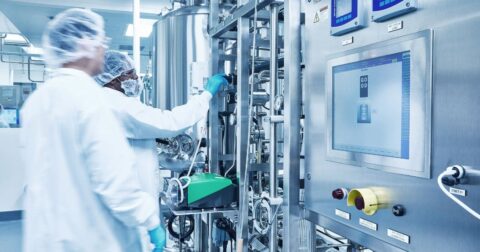Explainer
Agriculture Affects Deforestation Much More Than Most People Realize
Climate•7 min read
Reported
A new study says lab grown meat is worse for the planet than beef, but what do the numbers actually say?


Words by Björn Ólafsson
Lab grown meat is back in the news as two companies announce they’ve cleared the final regulatory hurdle to sell cultivated chicken to U.S. consumers. Grown from cells and brewed in reactors, cultivated meat is still expensive but what it offers is unparalleled — actual meat without the massive climate pollution caused by farming animals, amounting to around 14 percent of global greenhouse gas emissions.
Now, a new study from U.C. Davis is attracting significant media attention by calling these climate benefits into question, arguing that lab grown is actually much worse for the planet at around 25 times the emissions of beef. Made public by researchers in April, the study is a pre-print, meaning that it hasn’t been published in a scientific journal or subject to the rigors of peer review. But that hasn’t stopped a number of media outlets — the San Francisco Chronicle, Forbes and New Scientist among them — from reporting on the study without digging into the numbers.
According to Good Food Institute scientist Elliot Swartz, the study is flawed, and it all comes down to a couple of assumptions made by the U.C. Davis researchers that don’t match up with the reality of the industry.
In this new preprint, the researchers argue that cultured meat requires a lot more energy to produce, maybe as much as 25 times more. That’s a finding that diverges from the peer-reviewed research — the five published studies that include a lifecycle analysis co-authored by Swartz earlier this year.
In a recent letter to the U.C. Davis researchers who authored the preprint, Swartz lays out his case against their numbers. Key among his points — the researchers assumed cultivated meat makers would be using pharmaceutical-grade level ingredients in calculating the emissions costs. These materials require painstakingly long methods of purification and significantly more energy — around 20 times more than food grade — which is part of why the U.C. Davis study arrived at their much higher emissions calculations.
Only it’s not at all clear that cultivated meat companies will be using pharmaceutical-grade ingredients in the future. Research funded by the European Commission suggests it’s possible to make up to 99.2 percent of the feed using food-grade ingredients rather than pharma-grade. And at least one industry executive says that food-grade materials are already scaleable.
Multiple companies, including IntegriCulture, are now selling food-grade ingredients to cultivated meat companies in Asia. Dutch-based Meatable also claims to be testing a 70 percent food-grade formula, with plans to bump that number up even further in the future.
However, it’s also true the industry isn’t quite there yet. Of the four companies Sentient Media spoke to, only Good Meat confirmed that they are currently using a mix of food-grade and pharmaceutical grade. But all four companies said that they are actively working towards using as much food-grade materials as possible, and believe a switch is possible within a few years.
A number of cultivated meat companies and experts have also publicly criticized the assumptions of the U.C. Davis study. Cellular Agriculture Europe, a research and lobbying group, put out a statement calling the numbers driving the analysis an “unrealistic worst-case scenario.”
In response to a request for comment, lead author of the UC Davis study Derrich Risner says that cultivated meat faces many challenges in scaling up production, including making massive bioreactors operational and working to bring down the cost of feed ingredients. It’s not clear when or even if the cultivated meat industry will be successful in meeting these challenges, says Risner.
There are other problems with the study, suggests Swartz, who points out that the researchers calculated the energy to run the bioreactors based on numbers from a 2010 paper that assumed a much dirtier mix of energy than is actually available on the grid today.
Risner points out — and Swartz concedes — that an updated version of this paper does not exist. For his own analysis, Swartz did not rely on that paper, but modeled a number of energy estimates for 2030 based on different scenarios. Along with a team from CE Delft, an environmental consulting agency in the Netherlands, Swartz conducted a life-cycle assessment that remains the largest published analysis of cultivated meat’s environmental footprint.
In that paper, Swartz and his co-authors assumed most of the ingredients would be food-grade, and found that cultivated meat would generate up to 70 percent fewer greenhouse gas emissions than traditional beef by 2030. Cultivated meat would also emit fewer gasses than pork and could even fewer than chicken, as long as green energy was used in production. That said, a few observers have criticized these figures as potentially too optimistic.
The bottom line is that predicting the climate impact of new and evolving technologies is difficult. “The academic world is playing catch up to a very high degree,” says Swartz. “They’re years behind in terms of the research that’s been going on in the private industry.” For his part, Risner says that he and his team are doing short-term analysis, even as the field continues to grow.
Both scientists acknowledge that climate modeling of cultivated meat requires the researcher to make a number of assumptions, which means that for the foreseeable future there will always be some level of uncertainty in studies of this rapidly evolving industry. But reporters ought to make that uncertainty clear to readers, particularly when covering a single study that diverges from the research. This is especially critical when reporting on a topic that’s ripe for conspiracy. Considering we’re still calling it “lab grown,” cultivated meat definitely qualifies.